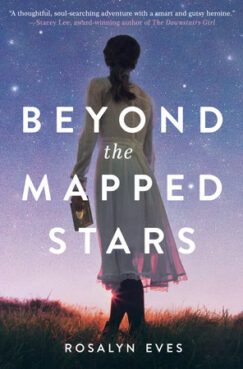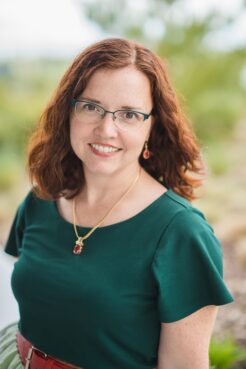
“Beyond the Mapped Stars” by Rosalyn Eves. Courtesy image
(RNS) — Authors and publicists contact me pretty often to pitch new books, and most of those pitches are blanket emails from people who don’t read this column or know its audience. So it was incredibly refreshing recently to hear about a new Knopf young adult novel that ticks so many boxes for my readers: Mormonism, feminism and American history.
Coming Tuesday (Aug. 24) from Penguin Random House’s “Knopf Books for Young Readers” imprint, “Beyond the Mapped Stars” is the story of a young LDS woman in pioneer Utah whose heart is telling her she’s supposed to become an astronomer, but whose family and church are telling her to get married and curtail her education. How can she stay true to her faith and family while also honoring her love of science and learning?
Utah author Rosalyn Eves had previously published YA fantasy fiction as part of the Blood Rose Rebellion series, so this foray into historical fiction — based on her own family history — breaks new ground for readers 12 and up. I greatly enjoyed reading it and speaking with Eves, who is a professor at Southern Utah University. This conversation has been edited for length and clarity.— JKR
Where did the idea and characters come from?
I was listening to an NPR interview with David Baron about the 1878 eclipse, and it was such a fascinating story, about all these people who converged on Denver and the impact it had for American science. But I started thinking, what would this look like for people who were already in the West? Because the whole story was about people who came from the Eastern intellectual centers to the Western frontier.
What if you were someone who wanted to be involved in that, to be an astronomer, but had no way of bridging that gap? You’re in a frontier town with limited education and limited resources, and you’ve never seen anybody do this thing that you want to do.
The main character came about because I went back to my own family history and found my grandfather’s grandmother, who was 18 in the summer of 1878. And then I just did a bunch of research into her and her family situation and the area she grew up in. I lucked out in that my cousin married a woman who’s from Monroe and so she took me around the town. She showed me the old Collings cabin that is still standing, and that belongs to one of the families in the novel.
You suggest in the afterword that the novel has a bit of your own story of being Mormon, but not always agreeing with things that have happened in the church. Can you talk about that a little bit more?

Rosalyn Eves, author of “Beyond the Mapped Stars” and other novels. Courtesy photo
I think it’s hard to read any of the history and not realize how wrong they were on racial questions. When you go back, you see that Joseph Smith ordained people like Elijah Abel to the priesthood and that that priesthood restriction really was an invention of Brigham Young. Paul Reeve’s book “Religion of a Different Color” was so insightful and helpful to read, and made me realize how the LDS church spent most of the 20th century trying to prove that they were white. A lot of the racial stuff that comes from that is really troubling. And then, of course, I don’t agree with the church’s position on LGBTQ issues, and I know from some of the stuff that I’ve read that you’re kind of in the same boat.
So, there is that tension. I guess I feel about my church the way I feel about my country, which is there is a lot that I love about it and a lot of work that still needs to be done.
There aren’t a lot of nationally published books with LDS main characters. When you do get them, the narrative is that the main character has faith but also has questions, and they end up leaving their conservative faith for a more progressive faith. I wanted to open a space where they could have both. Because I think a lot of people, especially teens, are in this space where they both believe in and care about their tradition, but there’s also a lot they don’t agree with. It’s very clear that the rising generation is not on board with all of the official positions of the church. I wanted to write a story that allowed for some degree of comfort with having questions. I don’t know if that came through, but that’s what I was trying to do.
It definitely came through. What did you learn about Mormon life in the 19th century that surprised you?
Eves:
Two things surprised me, and they’re kind of in tension with each other. One is just how much a part of everybody’s daily lives the church could be. They had two meetings on Sunday. They had midweek meetings. They had Thursday fast days, and they were encouraged to be part of church organizations like the Mutual Improvement Association (which became Young Women/Young Men), which was just getting started, and the retrenchment associations.
At the same time, church activity was pretty low. We think about those early pioneers as being so devout and faithful. But for some of them, the act of coming to Utah was their big manifestation of faith, and their activity rates hovered around 25 or 30%.
The other thing is that I don’t think I was as aware of the role of women giving blessings until I really started getting into the research. I have to say that was also kind of disheartening, that women in the 19th-century church had a lot more autonomy and spiritual authority than women do today. They ran their own meetings, they had their own finances and their own magazines, and then they gave spiritual blessings, which were really beautiful to learn about. So that was something I wanted to put in the book. I’m grateful that my editors let me keep it in.
Meet Eves this week:
Tuesday: In-person event at the Frontier Homestead in Cedar City, Utah, 6:30–8 p.m. MST
Wednesday: Virtual event with the King’s English at 6 p.m. MST
Thursday: In-person event at the Provo library at 7 p.m. MST
Related content on Mormonism and the arts:
My favorite Mormon comic is now a full-on graphic novel
“Despicable Me” creator on Mormonism, Minions, and “the best calling in the Church”





